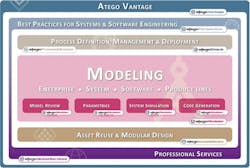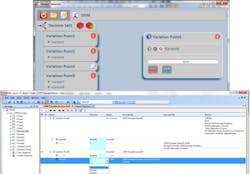Related Articles
- ARMing Ada
- Solver Handles What-If Scenarios For Medical And Other Applications
- Atego And Real Time Garbage Collection
Atego Vantage combines a number of model-based tools to simplify system and product line designs and improve reuse of components. This helps increase productivity, improve quality and reduces costs while reducing errors through the use of common, proven parts.
The core of the system is Atego Modeler. It supports UML, SysML, UPDM and Orthogonal Variability Modeling (OVM), an ISO 26550 industry standard. Support for the Object Management Group's (OMG) Common Variability Language (CVL) is in the works.
Atego Modeler can essentially support the “150%” model (Fig. 2). That is, a model that includes all options within the design. A particular instance will utilize a subset of these options but it makes maintaining a common framework significantly easier. Each variant is an instance of the complete model.
Atego Modeler runs on Atego's Artisan Studio. This supports these tools as well as other Atego compilers. Atego Modeler can be configured for automatic code generation from models into C, C++, C#, Java, Visual Basic and Ada. The tools can be synchronized with 3rd party tools like PTC Itegrity, The Mathworks Simulink and IBM Rational DOORS.
Atego Vantage also includes Atego Asset Library, Atego Process Director and Atego Check. Atego Vantage provides a common database index to link to these modular system and software design tools. Vantage is based on the Atego Perspective best practice implementation methodology and it supports a top-down, architected modular design while providing bottom-up asset mining and reuse of models.
The Atego Asset Library uses a supplier/consumer where “variable assets” can be used in the modeling process. It has a simple, web browser-based interface that uses an OMG Reusable Asset Specification (RAS). It is file type agnostic allowing easy integration with other tools. It includes a reuse metrics dashboard.
Atego Process Director and Atego Check tend to be used in conjuction with each other. They help author, manage, deploy and audit the Atego Perspective process. The tools work well with other systems and software engineering methodologies allowing developers to customize the process to their needs. For example, Process Director can export XML to tools like Microsoft Project. There is also an API that provides likes to tools like SAP and Microsoft Project.
About the Author
William G. Wong
Senior Content Director - Electronic Design and Microwaves & RF
I am Editor of Electronic Design focusing on embedded, software, and systems. As Senior Content Director, I also manage Microwaves & RF and I work with a great team of editors to provide engineers, programmers, developers and technical managers with interesting and useful articles and videos on a regular basis. Check out our free newsletters to see the latest content.
You can send press releases for new products for possible coverage on the website. I am also interested in receiving contributed articles for publishing on our website. Use our template and send to me along with a signed release form.
Check out my blog, AltEmbedded on Electronic Design, as well as his latest articles on this site that are listed below.
You can visit my social media via these links:
- AltEmbedded on Electronic Design
- Bill Wong on Facebook
- @AltEmbedded on Twitter
- Bill Wong on LinkedIn
I earned a Bachelor of Electrical Engineering at the Georgia Institute of Technology and a Masters in Computer Science from Rutgers University. I still do a bit of programming using everything from C and C++ to Rust and Ada/SPARK. I do a bit of PHP programming for Drupal websites. I have posted a few Drupal modules.
I still get a hand on software and electronic hardware. Some of this can be found on our Kit Close-Up video series. You can also see me on many of our TechXchange Talk videos. I am interested in a range of projects from robotics to artificial intelligence.



